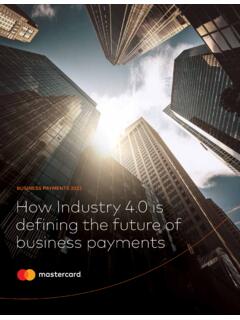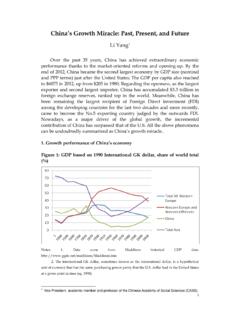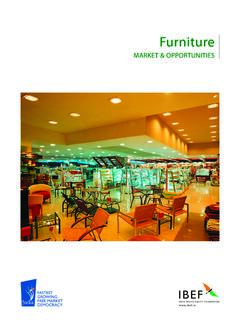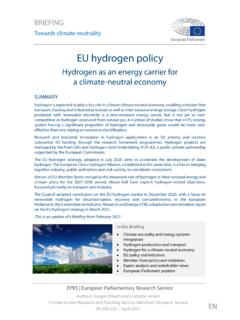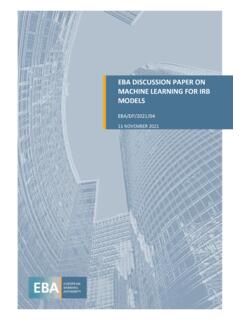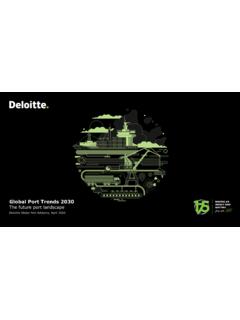Transcription of New Technology and Automation in Freight Transport and ...
1 New Technology and Automation in Freight Transport and Handling Systems future of Mobility: Evidence Review Foresight, Government Office for ScienceNew Technology and Automation in Freight Transport and Handling Systems New Technology and Automation in Freight Transport and Handling Systems Daniela Paddeu, Thomas Calvert, Ben Clark, Graham Parkhurst University of the West of England, Bristol February 2019 This report has an information cut-off date of June review has been commissioned as part of the UK government s Foresight future of Mobility project. The views expressed are those of the author and do not represent those of any government or organisation. This document is not a statement of government policy. New Technology and Automation in Freight Transport and Handling Systems 1 1. Contents 1.
2 Contents .. 1 2. Executive summary .. 3 a. Key technologies .. 3 b. Drivers and constraints on innovation .. 4 c. Implications for policy and research .. 4 3. Introduction .. 7 4. Methodology .. 8 5. Literature review .. 9 a. Automated loading systems at ports and depots .. 9 b. Self-driving or remote-controlled units and stacking 15 c. Freight Transport of the future .. 16 6. Disruptive business models .. 35 7. Stakeholder requirements .. 39 a. The carrier .. 39 b. The shipper .. 39 c. The truck driver .. 39 d. The regulator .. 40 e. The systems provider .. 40 f. The policymaker .. 40 g. Driver training service providers .. 41 h. Service providers of business support and education 41 i. System providers for platooning coordination .. 41 8. Enablers and barriers .. 41 a. Enablers .. 43 b. Barriers .. 46 9. Building the future .
3 47 a. Implications: a macroeconomic perspective .. 48 New Technology and Automation in Freight Transport and Handling Systems 2 b. Implications for sector employment and inequalities .. 48 c. Implications for the trucking industry and logistics service providers .. 52 d. Implications for the environment .. 53 e. What the Freight future might look like in the UK .. 54 10. Recommendations .. 57 11. References .. 59 New Technology and Automation in Freight Transport and Handling Systems 3 2. Executive summary This report presents a state-of-the-art review of new technologies and Automation in Freight Transport and handling. The review identifies: key emerging technologies, how are they being applied in the UK, and examples of (international) best practice the drivers of, and constraints on, innovation in the UK Freight sector implications for policies and research a.
4 Key technologies With respect to long-haul road transportation, the strongest prospects in the short to medium term relate to platooning1 of heavy goods vehicles (HGVs). The Technology is already mature, and the next step will be to develop, through trials, the appropriate regulatory frameworks and operating practices to enable the safe platooning of HGVs on public highways. Over the longer term, there is potential for autonomous electric and connected vehicles to be utilised in the Freight sector . In relation to long-haul rail transportation, on the european continent, high-speed rail lines are utilised already as rolling motorways through which Freight containers are transported for the longest part of the journey. Various transhipment systems have been developed to automate the transfer of cargo containers between road and rail ( CargoBeamer, the Lohr Railway System and InnovaTrain).
5 Such systems could be readily deployed on new sections of the UK rail network ( High Speed lines 1 and 2; HS1 and HS2), since these will meet the required design standards. Emerging solutions for last-mile deliveries include autonomous vehicles (AVs), drones and 3D printing. These can be combined in urban Freight systems with local cross-docking centres for receiving and collecting goods: consolidation centres, pick-up points and pack stations. With the establishment of the necessary regulatory frameworks, there is potential for such innovative solutions to reduce road Freight movements in urban areas. Figure 1 summarises some innovative technologies, splitting them by where they operate, air or road. As Transport is a system, changes in one part will also impact other modes. 1 Platooning is the grouping of vehicles in operation on a highway in such a way that their control systems are temporarily linked, which enables the space between the vehicles to be reduced.
6 In turn, greater proximity results in more efficient use of roadspace and increased energy efficiency for second and subsequent vehicles in a platoon. The lead vehicle also has an aerodynamic advantage, and lower fuel consumption. More generally it refers both to the connection of the vehicles through a data link, but also limited or partial Automation for following vehicles as the control systems are linked. New Technology and Automation in Freight Transport and Handling Systems 4 b. Drivers and constraints on innovation As well as being a necessary component of an internationally-leading economy fit for the information age, the provision of nationwide superfast/gigabit broadband and high-speed mobile networks will also be fundamental to stimulating innovation in the Freight sector . Such high-capacity data transmission networks may help unlock the potential for: increased capacity to transmit logistics data between Freight providers (and to customers), to improve efficiency in Freight operations the operation of automated drones for last-mile deliveries Views differ as to whether future self-driving Freight vehicles will need to be connected and if so how.
7 For safety reasons, some operation without active real time remote data feeds, is likely to have to be designed into systems. Will vehicle-to-vehicle, vehicle-to-infrastructure or vehicle-to-cloud technologies be necessary? If such connectivity becomes necessary, then any such connections will also need to ensure the safety of the vehicle and its data. However, compelling and reliable evidence of supply chain efficiency gains and cost reductions is necessary to incentivise private sector stakeholders to invest in these new technologies. Conversely, the review points towards a number of factors that could stifle innovation in the Freight sector , including: if the autonomous operation model pursued requires complementary infrastructure, then this will need to be in place. However, this is unnecessary for many current operating models a perception of limited added value and comparatively poor economies of scale associated with new technologies, which are likely to require high capital investments in the early development stages a lack of compelling evidence that new technologies are safe, reliable, cyber secure and offer efficiency gains and cost savings a collective resistance to change operating practices among institutions and the labour force, which may arise in part from an ongoing social norm that places greater trust in human control than machine control c.
8 Implications for policy and research At a high level, the review s findings imply that an integrated package of measures to support innovation in Freight handling and movement should include the following: 1. Continued investment in nationwide high-speed, high-capacity data transmission networks (both fibre-optic and mobile). 2. Ensuring that legislative and regulatory frameworks are adapted to enable the use of AVs on the public highway network. This includes giving due consideration New Technology and Automation in Freight Transport and Handling Systems 5 to standards for vehicles, roadside infrastructure and the regulation of AV operation on public highways. 3. Ensuring that the future rail Freight strategy allows for the potential deployment of rolling motorways on new sections of the rail network, along with complementary transhipment points2, as is happening on the european continent.
9 4. Developing a strategic plan to support the private sector to adopt and develop new systems of Freight handling and movement, including: (a) providing financial support for research and development programmes, with trials objectively and fully evaluated (to generate compelling evidence of efficacy relevant for knowledge transfer the sector ); and (b) training programmes to increase workforce capacity regarding the adoption of new operating practices. In addition, consideration might be given to calls (for example, by the Institute for Public Policy Research (Lawrence et al., 2017) for the establishment of a National Robotics and Artificial Intelligence Ethics Authority to advise on the ethics of Automation . The authority s potential remit could include: giving consideration to human safety in proximity to autonomous technologies examining liability issues in cases where autonomous technologies fail advising on socially equitable strategies to deal with circumstances where human labour is replaced by automated Technology Finally, it is noted that further primary research in the form of an in-depth analysis of the UK supply chain (considering different sectors, automotive, food, coal) is required to identify the prospects for applying different automated Freight systems.)
10 Such an analysis could be carried out at regional and national levels, giving consideration to the major Freight corridors across the UK. 2 A transhipment point is a place located between origin and final destination where goods or containers are in some way transferred from vehicle to vehicle, or vehicle to temporary storage facility. Reasons for transhipment might be changing of the means of Transport during the journey, or consolidation/deconsolidation ( combining small shipments into a large shipment or dividing the large shipment at the end of a trunk haul). New Technology and Automation in Freight Transport and Handling Systems 6 Figure 1: Key technologies identified across the supply chainNew Technology and Automation in Freight Transport and Handling Systems 7 3.











